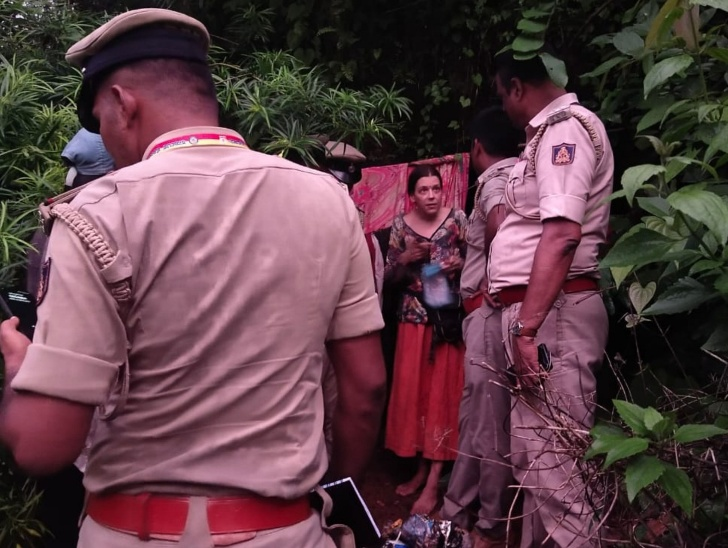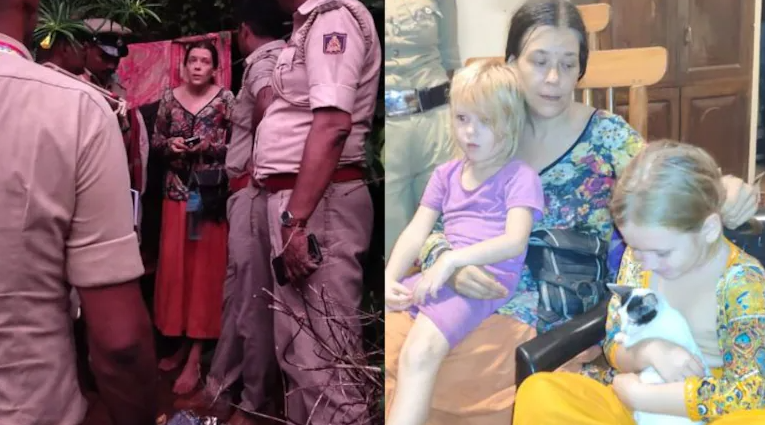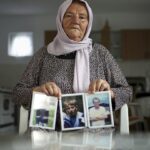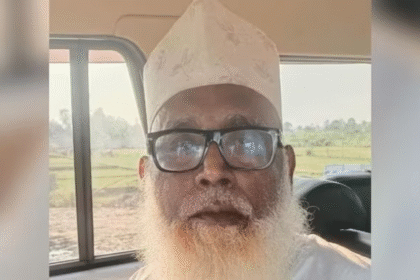Uncovered After 4 Years: Russian Woman, 2 Daughters Living in Karnataka Cave
4-year survival story of a Russian woman found living with her 2 daughters in a cave in Karnataka without access to modern facilities, raising questions about isolation and endurance.
A Hidden Life Unearthed—Discovery on Ramatirtha Hill
On July 9, 2025, at approximately 5:00 PM, an otherwise routine patrol in Karnataka’s Gokarna town led to a discovery that startled the authorities and raised immediate concerns regarding safety, legality, and humanitarian welfare. A police team led by Inspector Sridhar SR from Gokarna Police Station was surveying the forested Ramatirtha Hill region—an area known for tourist activity as well as its susceptibility to landslides and wildlife encounters.
While navigating the dense foliage atop the hill, the team noticed subtle movement near a large, concealed cave formation. What they uncovered was a makeshift shelter tucked into the rocky enclave. Inside it lived a woman, later identified as Nina Kutina, a 40-year-old of Russian origin, along with her two daughters, Prema (6 years, 7 months) and Ama (4 years). The trio appeared calm yet visibly isolated from society, their belongings modestly spread across stone surfaces and earthen flooring.
Upon questioning, Nina shared that she had travelled from Goa to Gokarna in pursuit of spiritual solitude. She had chosen the forest cave intentionally—believing it to be an ideal retreat for meditation, prayer, and spiritual disconnection from urban life. Her voice, although composed, hinted at deep conviction about her lifestyle choice. Authorities, however, were alarmed not only by the precarious environment of their makeshift home but especially by the risks posed to the two minor children.
Ramatirtha Hill is not just a forested tourist destination—it is marked as a landslide-prone zone, having experienced significant geological instability as recently as July 2024. Moreover, it is home to dangerous wildlife, including venomous snakes and other forest predators. The cave, located in a remote cliffside with limited access, lacked any form of safety provisions, sanitation, or communication with the outside world.
Rescue, Relocation, and the Path to Safety
Following an immediate risk assessment, the police team prioritised relocating the family to a safer environment. After counselling Nina on the dangers of her dwelling—especially regarding the vulnerability of her children—the authorities were able to escort the family down the hill safely. Though she was hesitant to abandon the cave, Nina eventually cooperated under the assurance that her spiritual needs would be respected.
At Nina’s request, the police arranged for her and the girls to be housed at an ashram in Bankikodla village, located in the Kumta taluk of Uttara Kannada district. The ashram, run by Swami Yogaratna Saraswati, an 80-year-old female monk known for her spiritual teachings and humanitarian outreach, accepted the family into its fold.
The relocation marked a significant step away from the isolation Nina had sought. The ashram provided basic shelter, food, and access to health and hygiene services, while also serving as a holding place for the ongoing official investigation into the woman’s identity, immigration status, and the welfare of her children.
During the transition, Nina exhibited reluctance to share specific details about her travel documents, including her passport and visa status. Welfare officers and ashram staff engaged in multiple rounds of dialogue with her, ensuring she felt safe and understood the necessity of full disclosure. Eventually, she admitted that her documents were possibly lost in the forest cave where she had resided for years.
This prompted a joint search operation by the Gokarna Police and Forest Department, who returned to the cave and conducted a systematic recovery of the woman’s personal belongings.
Visa Violations, Legal Proceedings, and Protective Custody
Following the recovery of her travel documents from the cave, police and immigration officers were able to piece together Nina Kutina’s immigration history. According to records obtained from the Foreigners Regional Registration Office (FRRO) in Panaji, Goa, Nina had originally entered India on a Business Visa that was valid until April 17, 2017.
An Exit Permit was subsequently issued to her on April 19, 2018, and documents confirmed that she exited India for Nepal shortly after. However, records also revealed that she re-entered India on September 8, 2018, and had not reported to immigration authorities since. This indicated a clear overstay of visa terms, thereby constituting a violation under the Foreigners Act, 1946.
This revelation triggered an official immigration case against her. The Gokarna Police, in collaboration with FRRO officials, filed a report documenting her visa overstay and her prolonged illegal stay in Indian territory. The case was treated with urgency, considering the presence of minor children who, although born outside India, were now under the guardianship of a foreign national living in an unregulated and risky manner.
In accordance with procedure and in view of child safety concerns, the authorities made arrangements to transfer Nina and her daughters to the Women’s Reception Centre in Karwar, operated by the Department of Women and Child Development, Government of Karnataka. The center offered basic shelter, medical check-ups, nutritional aid, and emotional counselling to all three individuals.
Officials at the shelter confirmed that both children appeared physically healthy but were receiving psychological evaluation and trauma support. Welfare officers noted the children had no formal schooling, vaccination records, or consistent access to healthcare during their cave stay. These findings deepened the urgency of official interventions.
Simultaneously, the Superintendent of Police, Uttara Kannada, initiated formal correspondence with the FRRO Bengaluru to expedite the legal processes related to Nina’s deportation. Given her status as an overstaying foreign national, Nina and her daughters were now subject to immigration laws mandating removal from Indian territory. However, the presence of minors, coupled with the sensitive nature of her spiritual motivations, required the authorities to tread carefully.
As part of the legal steps, Nina would soon be produced before immigration officers in Bengaluru. A formal inquiry would be conducted regarding her undocumented stay, missing records, intent of re-entry, and overall compliance with Indian immigration policies.
To ensure fairness, authorities confirmed that no criminal charges were being framed under the Indian Penal Code, as her stay did not appear to be linked to any harmful or illegal activity beyond immigration rule violations. The primary focus remained the welfare of the children and an orderly repatriation of the family in coordination with Russian diplomatic missions.
Cultural Context, Legal Ambiguities, and Public Debate Over Spiritual Asylum
As news of the discovery spread across Indian and international media, it triggered a larger public conversation around spiritual nomadism, immigration enforcement, child safety, and India’s stance on spiritual asylum. The case of Nina Kutina, while unusual, was not without precedent. India, historically a magnet for seekers, wanderers, yogis, and spiritual practitioners from around the world, has long presented a paradox: openness to metaphysical exploration, coupled with a complex legal framework for foreigners.
In spiritual and alternative living circles, especially among foreigners who have traveled to India for retreats and long-term meditation, there emerged a wave of sympathy for Nina’s choice. On several online forums and expat groups, users described her as a modern-day renunciate who embraced the ascetic lifestyle, similar to sadhus and monks who live in seclusion across India’s forests and mountains. Supporters argued that she had not committed a crime of malice, but rather exercised a deeply personal spiritual decision that happened to conflict with formal bureaucratic processes.
However, child rights activists and legal experts countered that the presence of two young children in an unsafe and isolated environment could not be overlooked. Children have the right to shelter, safety, education, and healthcare, which were unavailable in the Ramatirtha cave setting. These experts emphasized that parental spiritual choices must be weighed against their responsibilities to ensure basic developmental needs for minors.
The debate reached a new dimension when the Swami Yogaratna Saraswati Ashram, which had initially welcomed Nina, received a flurry of inquiries and even criticism for sheltering a foreign national with visa issues. Swami Yogaratna, in a public statement, clarified that the ashram was a spiritual refuge and had accepted the woman purely on humanitarian grounds, without prior knowledge of her immigration status.
Legal ambiguity also played a role in public confusion. India does not formally offer a visa category for “spiritual asylum” or indefinite meditative retreats. While Tourist, Business, Student, and Employment visas are the norm, those seeking extended spiritual residency often struggle to renew or adjust their status lawfully. This leads some, like Nina, to fall through the cracks.
In media interviews, former diplomats and legal scholars pointed out that India’s immigration laws—especially under the Foreigners Act—do not make provisions for contextual or compassionate exemptions, except through the rare provision of long-term visas on humanitarian grounds. These, however, require embassy certification, police verification, and periodic renewals, which Nina had neither applied for nor complied with.
Within public discourse, Nina’s story was increasingly seen as a collision of ancient Indian hospitality and modern state enforcement. While some hailed her discovery as a wake-up call for tighter border control, others demanded more nuanced visa policies for spiritual seekers who come to India with non-materialistic intentions.
Diplomatic Coordination, Repatriation Efforts, and Reflections on India’s Immigration Future
With the Russian woman and her two daughters now under protective custody, the focus of authorities shifted to diplomatic coordination and repatriation logistics. The Superintendent of Police, Uttara Kannada, initiated official correspondence with the Foreigners Regional Registration Office (FRRO), Bengaluru, and engaged with the Russian Consulate to begin documentation for deportation procedures.
In such cases, cooperation between the host government and the concerned embassy is essential. The Russian Consulate in Chennai, which oversees Karnataka, was formally notified of Nina Kutina’s immigration violation and the status of her minor daughters. In line with international protocol, consular staff were invited to meet with Nina and assess the welfare of the children. Sources within the Department of Women and Child Development confirmed that arrangements were being made to facilitate this visit at the Karwar Women’s Reception Centre.
A case dossier comprising Nina’s visa records, recovered passport, and statements made to local police was sent to immigration officials in Bengaluru. Authorities prepared for an in-camera hearing before a senior immigration officer, which would determine the legal classification of the violation and timelines for deportation. During such proceedings, foreign nationals are typically offered an opportunity to appeal on compassionate, humanitarian, or medical grounds—though such relief is rarely granted for cases involving prolonged overstay without registration.
Meanwhile, Russian authorities conveyed willingness to assist in the repatriation, confirming they would arrange for return travel and reintegration support for Nina and her children upon arrival. However, they also requested assurance that the children’s rights and well-being would remain protected until their departure.
Public and Media Response: Between Empathy and Enforcement
The wider public response to the unfolding story remained deeply divided. While many praised the Gokarna Police and child welfare officials for their swift and humane handling of the situation, others questioned the reactive nature of enforcement, highlighting how the family managed to live undetected in a high-risk forest zone for over four years.
Journalists, social workers, and religious scholars penned opinion pieces arguing that India should consider establishing a special visa framework for long-term spiritual retreatants, especially those with proven non-criminal records. Such a category, they suggested, could come with built-in restrictions and periodic checks without criminalizing the very pursuit of spiritual discipline that India is globally known for.
Others warned against romanticizing the case, especially where minors are involved. Legal experts reiterated that any form of extended stay must not come at the cost of a child’s fundamental rights to food, healthcare, education, and safety.

The Road Ahead: Legal Closure and Policy Lessons
As of the latest update, a special immigration hearing is expected within the coming week. Pending the final ruling, Nina Kutina and her daughters will remain in state custody, receiving care and oversight. The final deportation order, once issued, will mark the end of this chapter—but its echoes are likely to be felt in legal and bureaucratic circles for much longer.
The Karnataka case highlights the urgent need for policy clarity on immigration, especially at the intersection of spiritual tourism, long-term residency, and child protection. Legal scholars have called for reforms that allow compassionate interpretation of intent, balanced with robust enforcement of national security and welfare regulations.
In conclusion, the tale of the Russian woman in a Gokarna cave is far more than a viral headline—it is a mirror reflecting India’s struggle to harmonize its spiritual legacy with the rule of law, and a prompt for legislators, diplomats, and civil society to reassess how compassion and compliance can coexist in a modern, multicultural democracy.
Spirituality and Sovereignty—Broader Implications for India’s National Identity
As the dust settles on the high-profile Gokarna cave episode, thinkers and policy commentators are reflecting on what the incident reveals about India’s evolving identity as both a spiritual beacon and a sovereign legal entity. The case of Nina Kutina underscores the tension between these dual roles: as a sanctuary for spiritual seekers and as a nation-state with defined borders, regulations, and responsibilities.
India has historically positioned itself as a land of moksha, sadhana, and renunciation—a refuge for those disillusioned with materialism or seeking inner truth. From the Beatles’ journey to Rishikesh in the 1960s to the millions of global spiritual tourists visiting today, the country’s soft power has been inextricably linked with its religious traditions and spiritual openness.
Yet in a post-globalisation, digitally surveilled world, such romantic narratives meet administrative challenges. The expectation that India can indefinitely play host to undocumented seekers—without addressing legal status, public safety, or diplomatic repercussions—is no longer sustainable.
Legal-Social Balance: Reforms Ahead?
Following Nina’s case, several advocacy groups and policy think tanks have proposed legal reforms. Chief among them is the idea of introducing a “Spiritual Residency Visa”—a limited, renewable visa category for foreigners engaged in meditation, monastic study, or voluntary isolation under institutional oversight. This visa would involve:
- Mandatory registration with a certified spiritual organisation
- Annual medical and psychological evaluations (especially when minors are involved)
- Proof of sustainable income or institutional support
- No participation in political activities or proselytization
Such a framework could preserve India’s spiritual magnetism while safeguarding its institutional integrity.
Global Comparison: What Other Nations Do
Comparative insights reveal that countries like Thailand, Bhutan, and even certain Buddhist prefectures in Japan have tailored visa categories or religious exemptions that allow extended spiritual stays—albeit with stringent oversight. In contrast, Western countries tend to restrict visa extensions for religious seclusion unless tied to educational institutions or formal monasteries.
India, standing at this crossroads, has an opportunity to pioneer a humane yet enforceable model that acknowledges its legacy while accommodating 21st-century expectations.
A Mirror to the Nation’s Priorities
Ultimately, the story of a Russian woman meditating in a cave with her children challenges India to ask deeper questions: How do we define sanctuary? Who do we welcome, and on what terms? Can compassion coexist with compliance?
Nina Kutina’s retreat into the wilderness may be ending, but the broader conversation about identity, policy, and human dignity is just beginning.
Also Read : ₹25 Lakh Gurgaon Apartment Hit by Extreme Rain: 3-Foot Waterlog Submerges Home in Luxury Society








